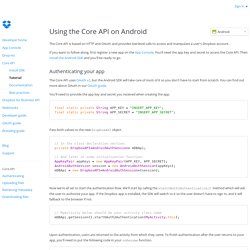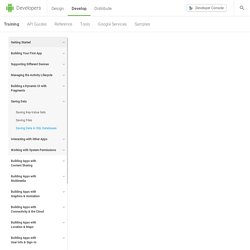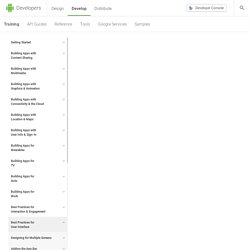

How to ship an Android application with a database? Android Programming: Pushing the Limits. Developers. Android Core API - Dropbox. The Core API is based on HTTP and OAuth and provides low-level calls to access and manipulate a user's Dropbox account.

If you want to follow along, first register a new app on the App Console. You'll need the app key and secret to access the Core API. Then install the Android SDK and you'll be ready to go. Authenticating your app The Core API uses OAuth v2, but the Android SDK will take care of most of it so you don't have to start from scratch. Android SQLite database and content provider. Getting Started with Data Binding in Android. Data Binding Guide. This document explains how to use the Data Binding Library to write declarative layouts and minimize the glue code necessary to bind your application logic and layouts.

The Data Binding Library offers both flexibility and broad compatibility — it's a support library, so you can use it with all Android platform versions back to Android 2.1 (API level 7+). To use data binding, Android Plugin for Gradle 1.3.0-beta4 or higher is required. Beta release Please note that the Data Binding library is a beta release.
While Data Binding is in beta, developers should be aware of the following caveats: This is a beta release of the feature intended to generate developer feedback. Build Environment. Google. Saving Data in SQL Databases. Saving data to a database is ideal for repeating or structured data, such as contact information.

This class assumes that you are familiar with SQL databases in general and helps you get started with SQLite databases on Android. The APIs you'll need to use a database on Android are available in the android.database.sqlite package. Define a Schema and Contract One of the main principles of SQL databases is the schema: a formal declaration of how the database is organized.
Android 4 beginners. By logging in to this service, you are agreeing to the following Regulations and Policies.

If you do not understand any of the Regulations or Policies, or if you do not agree to fully abide by them, then you should not use this service. Specifically, you must ensure that you keep your login details confidential and you may not allow any third party to use your account. All login attempts are monitored and all suspicious account activity is investigated. In extreme circumstances, your network account may be disabled. Google Developers. Creating a Fragment. You can think of a fragment as a modular section of an activity, which has its own lifecycle, receives its own input events, and which you can add or remove while the activity is running (sort of like a "sub activity" that you can reuse in different activities).

This lesson shows how to extend the Fragment class using the Support Library so your app remains compatible with devices running system versions as low as Android 1.6. Note: If you decide that the minimum API level your app requires is 11 or higher, you don't need to use the Support Library and can instead use the framework's built in Fragment class and related APIs. Just be aware that this lesson is focused on using the APIs from the Support Library, which use a specific package signature and sometimes slightly different API names than the versions included in the platform. Getting Started. Action Bar. The action bar is a window feature that identifies the user location, and provides user actions and navigation modes.

Using the action bar offers your users a familiar interface across applications that the system gracefully adapts for different screen configurations. Figure 1. An action bar that includes the [1] app icon, [2] two action items, and [3] action overflow. The action bar provides several key functions: Provides a dedicated space for giving your app an identity and indicating the user's location in the app. For more information about the action bar's interaction patterns and design guidelines, see the Action Bar design guide. The ActionBar APIs were first added in Android 3.0 (API level 11) but they are also available in the Support Library for compatibility with Android 2.1 (API level 7) and above.
FloatingActionButton. Classroom. Introduction to Android. Welcome to the Android developer guides.

These documents teach you how to build Android apps using APIs in the Android framework and other libraries. If you're brand new to Android and want to jump into code, start with the Build Your First App tutorial. And check out these other resources to learn Android development: Codelabs: Short, self-paced tutorials that each cover a discrete topic. Most codelabs step you through the process of building a small app, or adding a new feature to an existing app. Otherwise, the following is a small selection of essential developer guides that you should be familiar with. Essential documentation Online training. Pro android 4. By logging in to this service, you are agreeing to the following Regulations and Policies.

If you do not understand any of the Regulations or Policies, or if you do not agree to fully abide by them, then you should not use this service. Specifically, you must ensure that you keep your login details confidential and you may not allow any third party to use your account. All login attempts are monitored and all suspicious account activity is investigated. In extreme circumstances, your network account may be disabled. Creating Lists and Cards. Para criar listas e cartões complexos com estilos do Material Design no seu aplicativo, você pode usar os widgets RecyclerView e CardView .

Criar listas O widget RecyclerView é uma versão mais avançada e flexível do ListView. Esse widget é um contêiner para exibir grandes conjuntos de dados que podem ser rolados com muita eficiência ao manter um número limitado de visualizações. Use o widget RecyclerView quando tiver coletas de dados cujos elementos mudam durante a execução baseados na ação do usuário ou em eventos de rede. Android ListView – Tutorial and basic example. Topics covered Android ListView SimpleAdapter ListView onClickListener ListView menu context:ContextMenuInfo and AdpaterContextMenuInfo One of the UI component we use often is ListView, for example when we need to show items in a vertical scrolling list.

In order to show items inside the list, this component uses an adapter, so if we want to populate the list we have first create or use existing adapters. DezQ/ContactManager. Material Design. Developer Docs Creating Apps with Material Design Video Introduction to Material Design Paper and Ink: The Materials that Matter Material Design in the Google I/O App Material design is a comprehensive guide for visual, motion, and interaction design across platforms and devices. Building a Simple User Interface. Android Design Principles. These design principles were developed by and for the Android User Experience Team to keep users' best interests in mind. For Android developers and designers, they continue to underlie the more detailed design guidelines for different types of devices. Sign in - Google Accounts. Adding SDK Packages. By default, the Android SDK does not include everything you need to start developing. The SDK separates tools, platforms, and other components into packages you can download as needed using the Android SDK Manager.